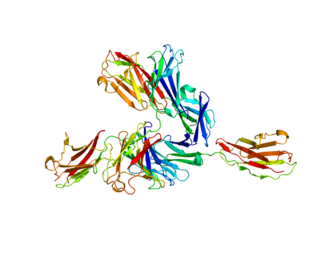
Excitatory amino-acid transporter 5 (EAAT5) is a protein that in humans is encoded by the SLC1A7 gene.

Basigin (BSG) also known as extracellular matrix metalloproteinase inducer (EMMPRIN) or cluster of differentiation 147 (CD147) is a protein that in humans is encoded by the BSG gene. This protein is a determinant for the Ok blood group system. There are three known antigens in the Ok system; the most common being Oka, OK2 and OK3. Basigin has been shown to be an essential receptor on red blood cells for the human malaria parasite, Plasmodium falciparum. The common isoform of basigin (basigin-2) has two immunoglobulin domains, and the extended form basigin-1 has three.

Thiamine transporter 1, also known as thiamine carrier 1 (TC1) or solute carrier family 19 member 2 (SLC19A2) is a protein that in humans is encoded by the SLC19A2 gene. SLC19A2 is a thiamine transporter. Mutations in this gene cause thiamine-responsive megaloblastic anemia syndrome (TRMA), which is an autosomal recessive disorder characterized by diabetes mellitus, megaloblastic anemia and sensorineural deafness.

Bestrophin-1 (Best1) is a protein that, in humans, is encoded by the BEST1 gene.

High affinity cationic amino acid transporter 1 is a protein that in humans is encoded by the SLC7A1 gene.

Monocarboxylate transporter 5 is a protein that in humans is encoded by the SLC16A4 gene.

Monocarboxylate transporter 8 (MCT8) is an active transporter protein that in humans is encoded by the SLC16A2 gene.

Sodium- and chloride-dependent taurine transporter is a protein that in humans is encoded by the SLC6A6 gene.

Cationic amino acid transporter 3 is a protein that in humans is encoded by the SLC7A3 gene.

Monocarboxylate transporter 4 (MCT4) also known as solute carrier family 16 member 3 is a protein that in humans is encoded by the SLC16A3 gene.

Sodium-coupled monocarboxylate transporter 1 is a protein that in humans is encoded by the SLC5A8 gene.

Monocarboxylate transporter 1 is a ubiquitous protein that in humans is encoded by the SLC16A1 gene. It is a proton coupled monocarboxylate transporter.
The monocarboxylate transporters, or MCTs, are a family of proton-linked plasma membrane transporters that carry molecules having one carboxylate group (monocarboxylates), such as lactate, pyruvate, and ketones across biological membranes. MCTs are expressed in nearly every kind of cell.

Monocarboxylate transporter 10, also known as aromatic amino acid transporter 1 and T-type amino acid transporter 1 (TAT1) and solute carrier family 16 member 10 (SLC16A10), is a protein that in humans is encoded by the SLC16A10 gene. SLC16A10 is a member of the solute carrier family.

Monocarboxylate transporter 9 is a protein that in humans is encoded by the SLC16A9 gene.
The lactate shuttle hypothesis describes the movement of lactate intracellularly and intercellularly. The hypothesis is based on the observation that lactate is formed and utilized continuously in diverse cells under both anaerobic and aerobic conditions. Further, lactate produced at sites with high rates of glycolysis and glycogenolysis can be shuttled to adjacent or remote sites including heart or skeletal muscles where the lactate can be used as a gluconeogenic precursor or substrate for oxidation. The hypothesis was proposed by professor George Brooks of the University of California at Berkeley.

Monocarboxylate transporter 6 (MCT6) is a protein in humans that is encoded by the SLC16A5 gene.

Monocarboxylate transporter 2 (MCT2) also known as solute carrier family 16 member 7 (SLC16A7) is a protein that in humans is encoded by the SLC16A7 gene. MCT2 is a proton-coupled monocarboxylate transporter. It catalyzes the rapid transport across the plasma membrane of many monocarboxylates such as lactate, branched-chain oxo acids derived from leucine, valine and isoleucine, and the ketone bodies acetoacetate and beta-hydroxybutyrate. It also functions as high-affinity pyruvate transporter.

The proton-coupled folate transporter is a protein that in humans is encoded by the SLC46A1 gene. The major physiological roles of PCFTs are in mediating the intestinal absorption of folate, and its delivery to the central nervous system.

Solute carrier family 16 member 12 is a protein that in humans is encoded by the SLC16A12 gene.













